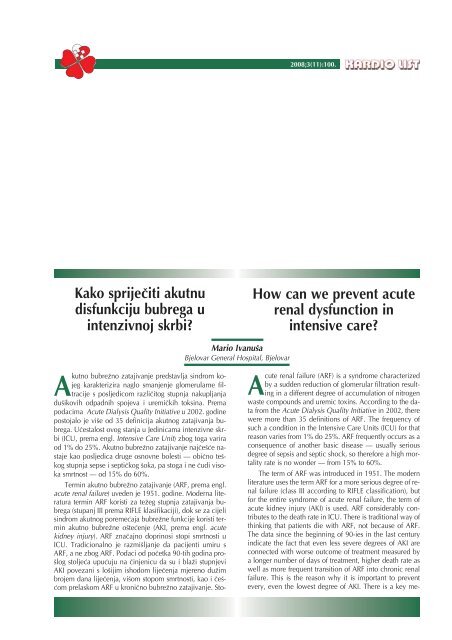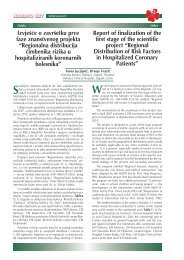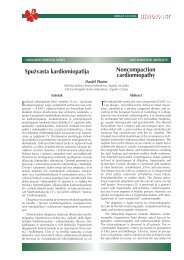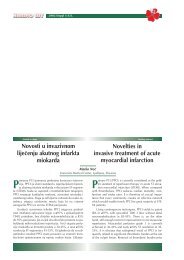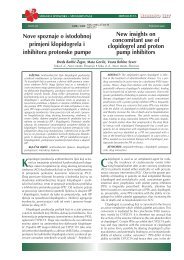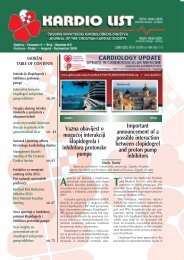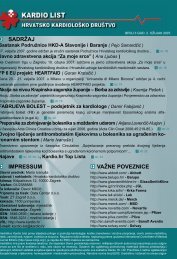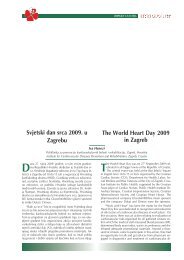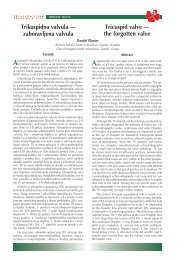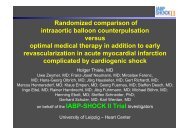2008;3(11):100. - Kardio.hr
2008;3(11):100. - Kardio.hr
2008;3(11):100. - Kardio.hr
Create successful ePaper yourself
Turn your PDF publications into a flip-book with our unique Google optimized e-Paper software.
<strong>2008</strong>;3(<strong>11</strong>):<strong>100.</strong><br />
Kako sprijeËiti akutnu<br />
disfunkciju bubrega u<br />
intenzivnoj skrbi?<br />
How can we prevent acute<br />
renal dysfunction in<br />
intensive care?<br />
Mario Ivanuπa<br />
Bjelovar General Hospital, Bjelovar<br />
Akutno bubreæno zatajivanje predstavlja sindrom kojeg<br />
karakterizira naglo smanjenje glomerularne filtracije<br />
s posljedicom razliËitog stupnja nakupljanja<br />
duπikovih odpadnih spojeva i uremiËkih toksina. Prema<br />
podacima Acute Dialysis Quality Initiative u 2002. godine<br />
postojalo je viπe od 35 definicija akutnog zatajivanja bubrega.<br />
UËestalost ovog stanja u Jedinicama intenzivne skrbi<br />
(ICU, prema engl. Intensive Care Unit) zbog toga varira<br />
od 1% do 25%. Akutno bubreæno zatajivanje najËeπÊe nastaje<br />
kao posljedica druge osnovne bolesti — obiËno teπkog<br />
stupnja sepse i septiËkog πoka, pa stoga i ne Ëudi visoka<br />
smrtnost — od 15% do 60%.<br />
Termin akutno bubreæno zatajivanje (ARF, prema engl.<br />
acute renal failure) uveden je 1951. godine. Moderna literatura<br />
termin ARF koristi za teæeg stupnja zatajivanja bubrega<br />
(stupanj III prema RIFLE klasifikaciji), dok se za cijeli<br />
sindrom akutnog poremeÊaja bubreæne funkcije koristi termin<br />
akutno bubreæne oπteÊenje (AKI, prema engl. acute<br />
kidney injury). ARF znaËajno doprinosi stopi smrtnosti u<br />
ICU. Tradicionalno je razmiπljanje da pacijenti umiru s<br />
ARF, a ne zbog ARF. Podaci od poËetka 90-tih godina proπlog<br />
stoljeÊa upuÊuju na Ëinjenicu da su i blaæi stupnjevi<br />
AKI povezani s loπijim ishodom lijeËenja mjereno duæim<br />
brojem dana lijeËenja, viπom stopom smrtnosti, kao i Ëeπ-<br />
Êom prelaskom ARF u kroniËno bubreæno zatajivanje. Sto-<br />
Acute renal failure (ARF) is a syndrome characterized<br />
by a sudden reduction of glomerular filtration resulting<br />
in a different degree of accumulation of nitrogen<br />
waste compounds and uremic toxins. According to the data<br />
from the Acute Dialysis Quality Initiative in 2002, there<br />
were more than 35 definitions of ARF. The frequency of<br />
such a condition in the Intensive Care Units (ICU) for that<br />
reason varies from 1% do 25%. ARF frequently occurs as a<br />
consequence of another basic disease — usually serious<br />
degree of sepsis and septic shock, so therefore a high mortality<br />
rate is no wonder — from 15% to 60%.<br />
The term of ARF was introduced in 1951. The modern<br />
literature uses the term ARF for a more serious degree of renal<br />
failure (class III according to RIFLE classification), but<br />
for the entire syndrome of acute renal failure, the term of<br />
acute kidney injury (AKI) is used. ARF considerably contributes<br />
to the death rate in ICU. There is traditional way of<br />
thinking that patients die with ARF, not because of ARF.<br />
The data since the beginning of 90-ies in the last century<br />
indicate the fact that even less severe degrees of AKI are<br />
connected with worse outcome of treatment measured by<br />
a longer number of days of treatment, higher death rate as<br />
well as more frequent transition of ARF into c<strong>hr</strong>onic renal<br />
failure. This is the reason why it is important to prevent<br />
every, even the lowest degree of AKI. There is a key me-
<strong>2008</strong>;3(<strong>11</strong>):101.<br />
ga je vaæno sprijeËiti svaki, pa i najmanji stupanj AKI.<br />
KljuËno je pitanje koji je mehanizam bubreænog oπteÊenja<br />
— predbubreæni (smanjena perfuzija bubrega), bubreæni<br />
(glomerularni ili neglomerularni) ili poslijebubreæni (opstrukcija<br />
u mokraÊnim putevima).<br />
Mjerama prevencije AKI nastoji se oËuvati funkcija<br />
bubrega, sprijeËiti smrtni ishod, sprijeËiti komplikacije (poremeÊaji<br />
tekuÊine, elektrolita i acidobaznog statusa) te<br />
sprijeËiti potrebu za kroniËnom dijalizom. Konzervativne<br />
metode za sprjeËavanje AKI ukljuËuju korekciju dehidracije,<br />
korekciju hipotenzije (odræavanje tlaka perfuzije bubrega)<br />
te ograniËenje izloæenosti nefrotoksiËnim tvarima. IzotoniËne<br />
otopine (fizioloπka, Ringer i sl.) primijenjene intravenozno<br />
opÊenito su prihvaÊen naËin sprjeËavanja AKI.<br />
Optimalna brzina i koliËina infuzijskih otopina nije definirana,<br />
te stoga mora biti prilagoappleena stanju pojedinog pacijenta.<br />
Niti srednji arterijski tlak nije definiran, a terapija vazopresornim<br />
lijekovima se treba zapoËeti tek po nadoknadi<br />
volumena. Suprotno uvrijeæenom miπljenju, podaci iz<br />
studija ne ukazuju na Ëinjenicu da je primjena norepinefrina<br />
povezana s veÊom uËestalosti AKI. Vezano uz nefrotoksiËne<br />
lijekove naroËit oprez je potreban kod primjene<br />
aminoglikozida (preporuËa se primjena u jednoj dnevnoj<br />
dozi), amfotericina i kontrastnih sredstava.<br />
Rezultati kliniËke primjene medikamenata, kao temelja<br />
farmakoloπke strategije sprjeËavanja AKI, su razoËaravaju-<br />
Êi. Primjena diuretika Henleove petlje korisna je za lijeËenje<br />
prekomjernog volumena, ali ne kod lijeËenja oligurije<br />
i u prevenciji AKI. Ukoliko se æeli primijeniti diuretik ove<br />
skupine u oliguriËnog bolesnika prije lijeËenja dijalizom<br />
valja to uËiniti oprezno, a ukoliko se ne postigne adekvatna<br />
diureza potrebno je odmah prekinuti primjenu lijeka<br />
da bi se sprijeËila ototoksiËnost. Takoappleer, niti primjena<br />
manitola, dopamina ili antagonista kalcija nije kliniËki djelotvorna<br />
u prevenciji AKI. Primjena N-acetilcisteina, te hidracije<br />
intravenozno uz otopinu bikarbonata moæe smanjiti<br />
uËestalost AKI nakon primjene kontrastnih sredstava,<br />
poglavito u osoba sa od prije poznatim oπteÊenjem bubreæne<br />
funkcije, dijabetesom i poznatom bolesti krvoæilnog<br />
sustava ili jetre. Uloga teofilina i profilaktiËke hemofiltracije<br />
u svrhu sprjeËavanja nefropatije izazvane kontrastom<br />
zahtjeva daljnja istraæivanja.<br />
Osoblje u ICU ima kljuËnu ulogu u otklanjanju uzroka<br />
i sprjeËavanju dodatnog oπteÊenja bubreæne funkcije, ukoliko<br />
se AKI prepozna dovoljno rano. Po osiguranju adekvatne<br />
funkcije vitalnih organa, odnosno hemodinamskoj i<br />
respiratornoj potpori, potrebno je dijagnosticirati uzrok, a<br />
potom se usredotoËiti na praÊenje i korekciju volumena,<br />
pratiti diurezu i ukoliko postoji indikacija primijeniti neku<br />
od metoda nadomjeπtanja bubreæne funkcije. O<strong>hr</strong>abruje<br />
podatak da u veÊine preæivjelih pacijenata s ARF slijedi<br />
oporavak bubreæne funkcije.<br />
Received: 8 th Oct <strong>2008</strong><br />
E-mail: mivanusa@vip.<strong>hr</strong><br />
chanism as to which is the renal damage mechanism —<br />
pre-renal (reduced kidney perfusion), renal (glomerular or<br />
non-glomerular) or post-renal (obstruction in urinary<br />
tracts).<br />
The prevention measures of AKI are applied as to preserve<br />
the renal function, prevent deathly outcome, prevent<br />
complications (disorders of fluids, electrolytes and acidobase<br />
status) and eliminate a need for c<strong>hr</strong>onic dialysis.<br />
Conservative methods applied for preventing AKI includes<br />
a correction of dehydration and hypotension (maintaining<br />
of pressure of renal perfusion) and limitation of exposure to<br />
nep<strong>hr</strong>otoxic substances. Isotonic solutions (saline solution,<br />
Ringer etc.) applied intravenously are generally accepted<br />
method of AKI prevention. Optimum speed and quantity of<br />
infusion solutions has not been defined, and so it must be<br />
adapted to the condition of a particular patient. Hardly has<br />
middle arterial pressure been defined, the therapy with vasopressive<br />
medications need to start only upon compensation<br />
of the volume. Contrary to the traditional opinion, the<br />
data from the studies does not indicate the fact that the administration<br />
of norepinep<strong>hr</strong>ine is connected with ever<br />
greater frequency of AKI. Related with nep<strong>hr</strong>otoxic medications,<br />
special precautionary measures are to be taken<br />
when administering aminoglycosides (administering in one<br />
daily dose is recommended), amphotericins and contrast<br />
agents.<br />
The findings of clinic application of medications, as a<br />
foundation of pharmacologic strategy of AKI prevention<br />
are disappointing. The administration of loop diuretics is<br />
useful for treatment of excessive volume, but not when<br />
treating oliguria and for the AKI prevention. If a diuretic of<br />
this group in oliguric patients prior to treatment by using<br />
dialysis is to be changed, this should be done carefully,<br />
and if no adequate diuresis has been achieved, it is necessary<br />
to interrupt the administration of the medication immediately<br />
as to prevent ototoxicity. Even the application of<br />
mannitol, dopamine or calcium antagonists has not been<br />
clinically efficient in AKI prevention. The application of N-<br />
acetylcysteine and hydration intravenously with the solution<br />
of bicarbonates may reduce the frequent occurrence<br />
of AKI after application of contrast agents, especially in<br />
persons with earlier renal function damage, diabetes and<br />
known disease of cardiovascular system or liver. The role<br />
of theophyllines and prophylactic hemofiltration for the<br />
purpose of prevention of contrast nep<strong>hr</strong>opathy requires further<br />
investigation.<br />
Personnel in the ICU have a key role in elimination of<br />
the cause and prevention of additional renal function damage<br />
if AKI is recognized early enough. After making sure<br />
that vital organs perform their vital functions or after having<br />
secured hemodynamic and respiratory support, it is necessary<br />
to diagnose a cause and focus on monitoring and correction<br />
of volume, monitor diuresis and in case of any indications,<br />
it is necessary to change some of the methods of<br />
compensating the renal function. The data which is encouraging<br />
is that with the greatest number of survived patients<br />
with ARF there follows convalescence of the renal<br />
function.


